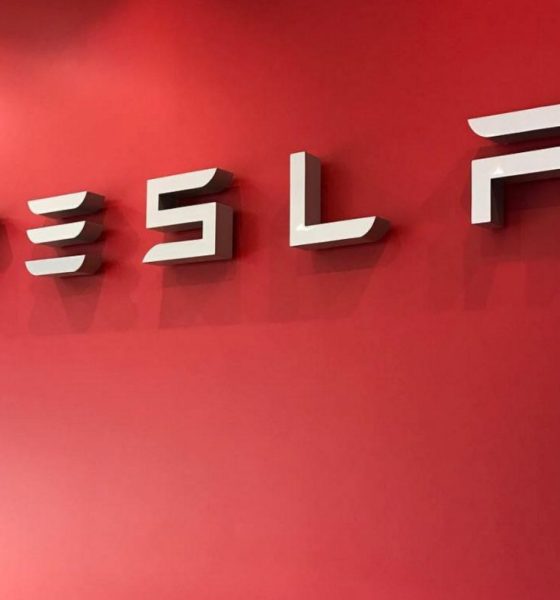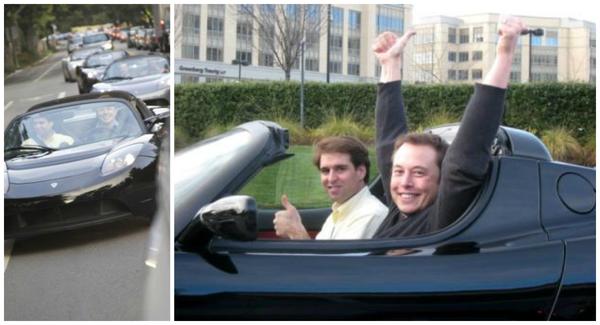

Investor's Corner
Ron Baron discusses Tesla, SpaceX, and a curious move by GM
Renowned mutual fund manager and investment icon Ron Baron of Baron Capital is well-known for his conservative, long-term approach to stock picking over his 46 year career. He’s been compared to Warren Buffett (both for his investing style and outstanding track record) and recently created a bit of a stir when he predicted Tesla stock could hit $1,000 by 2020.
 |
Elon Musk being interviewed by Ron Baron at the 2015 Baron Capital conference (Image: Baron Funds)
Baron Funds second quarter commentary (via Valuewalk) includes a letter from Ron Baron highlighting some fascinating insights surrounding Tesla. To understand businesses, Baron notes the importance of, “the individuals who lead those businesses; and of the character and talent of the individuals… In the end, we think it’s all about people.” Baron cites an unnamed Tesla executive who told him, “It is amazing to me how little most people know about Tesla.”
Baron explains, “Few institutional investors have met with Elon and JB. Fewer still, we’re guessing, have met with the co-founder’s teaching instructor at Stanford. We believe fewer and fewer in the investment industry are performing even the most basic research on businesses… Our meeting with Dr. Yadigaroglu is one example of Baron Funds’ differentiated primary research approach.”

Above: Tesla co-founders, CEO Elon Musk and CTO JB Straubel, in the early days driving Tesla’s Roadster “P1” (Images: Tesla)
Furthermore, it turns out that, “while at Stanford, Ion was the teaching instructor for JB Straubel, Tesla’s CTO and chief engineer. Ion believes JB and his team are better at battery technology than anyone else. It was lucky for Ion that he met both Elon and JB. Ion invested in Tesla when it was just beginning, and so far has made a lot more than he did in eBay. After meeting Ion, we concluded it was lucky for Elon and JB they met Ion as well.”So who is Dr. Yadigaroglu? Baron elaborates, “As part of our ongoing effort to gain further insight into Tesla’s prospects, we recently met with Dr. Ion Yadigaroglu, a venture capitalist. Ion is an engineer with a doctorate in physics from Stanford. Ion has been programming since he was eight years old! Ion’s dad is a prominent nuclear scientist. So much for Ion’s creds. When Ion studied at Stanford graduate school, his roommate founded eBay. Ion’s $1,300 investment in the eBay startup became worth millions. In 1992, at the dawn of the Internet, Ion met Elon Musk. Elon had come to Palo Alto to research battery technologies in Stanford’s labs.”
In studying Tesla, Baron also points out parallels with SpaceX. SpaceX, as Musk had originally envisioned it, has been able to reinvent the aerospace industry by reducing costs and, ultimately, saving millions with it’s reusable rockets. Baron reminds us, “Elon Musk’s SpaceX were [also] awarded contracts to design, build, and fly new spacecraft to ferry U.S. astronauts to the International Space Station (ISS)… The cost of commercial flights to the ISS will be a fraction of the cost of previous government flights, in part because rockets will be reusable.”
Similar to SpaceX, Musk’s emphasis on driving down costs remains mission critical at Tesla. Baron notes, “Despite Tesla’s requirements [for] functional design resulting in minimal waste, it often obtains better pricing for outsourced parts than its competitors. We believe its parts vendors try to accommodate this unique and fast growing company because they think Tesla’s engineering skills and designs will make them better suppliers! Further, since Tesla can insource production, it has the advantage of knowing exactly what a product should cost and how to produce it.”
And, according to Baron, GM is now following Tesla’s lead on this front. He notes that, “Mary T. Barra, General Motors’ CEO who has been trained as an engineer, has instructed her supply chain to ‘use Tesla suppliers…even if they cost more!’ Her rationale is that despite incurring higher costs to build a car, maintenance and warranty costs will be lower; car safety will be improved; and GM’s reputation will be enhanced.” That said, it might be worth pondering whether or not this move was executed strictly for reasons Baron stated in his letter — after all, GM has a tense, and sometimes adversarial, history with Tesla.
===
Note: Article originally published on evannex.com, by Matt Pressman
Source: Valuewalk via Baron Funds

Investor's Corner
Tesla stock closes at all-time high on heels of Robotaxi progress

Tesla stock (NASDAQ: TSLA) closed at an all-time high on Tuesday, jumping over 3 percent during the day and finishing at $489.88.
The price beats the previous record close, which was $479.86.
Shares have had a crazy year, dipping more than 40 percent from the start of the year. The stock then started to recover once again around late April, when its price started to climb back up from the low $200 level.
This week, Tesla started to climb toward its highest levels ever, as it was revealed on Sunday that the company was testing driverless Robotaxis in Austin. The spike in value pushed the company’s valuation to $1.63 trillion.
Tesla Robotaxi goes driverless as Musk confirms Safety Monitor removal testing
It is the seventh-most valuable company on the market currently, trailing Nvidia, Apple, Alphabet (Google), Microsoft, Amazon, and Meta.
Shares closed up $14.57 today, up over 3 percent.
The stock has gone through a lot this year, as previously mentioned. Shares tumbled in Q1 due to CEO Elon Musk’s involvement with the Department of Government Efficiency (DOGE), which pulled his attention away from his companies and left a major overhang on their valuations.
However, things started to rebound halfway through the year, and as the government started to phase out the $7,500 tax credit, demand spiked as consumers tried to take advantage of it.
Q3 deliveries were the highest in company history, and Tesla responded to the loss of the tax credit with the launch of the Model 3 and Model Y Standard.
Additionally, analysts have announced high expectations this week for the company on Wall Street as Robotaxi continues to be the focus. With autonomy within Tesla’s sights, things are moving in the direction of Robotaxi being a major catalyst for growth on the Street in the coming year.
Elon Musk
Tesla needs to come through on this one Robotaxi metric, analyst says
“We think the key focus from here will be how fast Tesla can scale driverless operations (including if Tesla’s approach to software/hardware allows it to scale significantly faster than competitors, as the company has argued), and on profitability.”

Tesla needs to come through on this one Robotaxi metric, Mark Delaney of Goldman Sachs says.
Tesla is in the process of rolling out its Robotaxi platform to areas outside of Austin and the California Bay Area. It has plans to launch in five additional cities, including Houston, Dallas, Miami, Las Vegas, and Phoenix.
However, the company’s expansion is not what the focus needs to be, according to Delaney. It’s the speed of deployment.
The analyst said:
“We think the key focus from here will be how fast Tesla can scale driverless operations (including if Tesla’s approach to software/hardware allows it to scale significantly faster than competitors, as the company has argued), and on profitability.”
Profitability will come as the Robotaxi fleet expands. Making that money will be dependent on when Tesla can initiate rides in more areas, giving more customers access to the program.
There are some additional things that the company needs to make happen ahead of the major Robotaxi expansion, one of those things is launching driverless rides in Austin, the first city in which it launched the program.
This week, Tesla started testing driverless Robotaxi rides in Austin, as two different Model Y units were spotted with no occupants, a huge step in the company’s plans for the ride-sharing platform.
Tesla Robotaxi goes driverless as Musk confirms Safety Monitor removal testing
CEO Elon Musk has been hoping to remove Safety Monitors from Robotaxis in Austin for several months, first mentioning the plan to have them out by the end of 2025 in September. He confirmed on Sunday that Tesla had officially removed vehicle occupants and started testing truly unsupervised rides.
Although Safety Monitors in Austin have been sitting in the passenger’s seat, they have still had the ability to override things in case of an emergency. After all, the ultimate goal was safety and avoiding any accidents or injuries.
Goldman Sachs reiterated its ‘Neutral’ rating and its $400 price target. Delaney said, “Tesla is making progress with its autonomous technology,” and recent developments make it evident that this is true.
Investor's Corner
Tesla gets bold Robotaxi prediction from Wall Street firm
Last week, Andrew Percoco took over Tesla analysis for Morgan Stanley from Adam Jonas, who covered the stock for years. Percoco seems to be less optimistic and bullish on Tesla shares, while still being fair and balanced in his analysis.

Tesla (NASDAQ: TSLA) received a bold Robotaxi prediction from Morgan Stanley, which anticipates a dramatic increase in the size of the company’s autonomous ride-hailing suite in the coming years.
Last week, Andrew Percoco took over Tesla analysis for Morgan Stanley from Adam Jonas, who covered the stock for years. Percoco seems to be less optimistic and bullish on Tesla shares, while still being fair and balanced in his analysis.
Percoco dug into the Robotaxi fleet and its expansion in the coming years in his latest note, released on Tuesday. The firm expects Tesla to increase the Robotaxi fleet size to 1,000 vehicles in 2026. However, that’s small-scale compared to what they expect from Tesla in a decade.
Tesla expands Robotaxi app access once again, this time on a global scale
By 2035, Morgan Stanley believes there will be one million Robotaxis on the road across multiple cities, a major jump and a considerable fleet size. We assume this means the fleet of vehicles Tesla will operate internally, and not including passenger-owned vehicles that could be added through software updates.
He also listed three specific catalysts that investors should pay attention to, as these will represent the company being on track to achieve its Robotaxi dreams:
- Opening Robotaxi to the public without a Safety Monitor. Timing is unclear, but it appears that Tesla is getting closer by the day.
- Improvement in safety metrics without the Safety Monitor. Tesla’s ability to improve its safety metrics as it scales miles driven without the Safety Monitor is imperative as it looks to scale in new states and cities in 2026.
- Cybercab start of production, targeted for April 2026. Tesla’s Cybercab is a purpose-built vehicle (no steering wheel or pedals, only two seats) that is expected to be produced through its state-of-the-art unboxed manufacturing process, offering further cost reductions and thus accelerating adoption over time.
Robotaxi stands to be one of Tesla’s most significant revenue contributors, especially as the company plans to continue expanding its ride-hailing service across the world in the coming years.
Its current deployment strategy is controlled and conservative to avoid any drastic and potentially program-ruining incidents.
So far, the program, which is active in Austin and the California Bay Area, has been widely successful.








